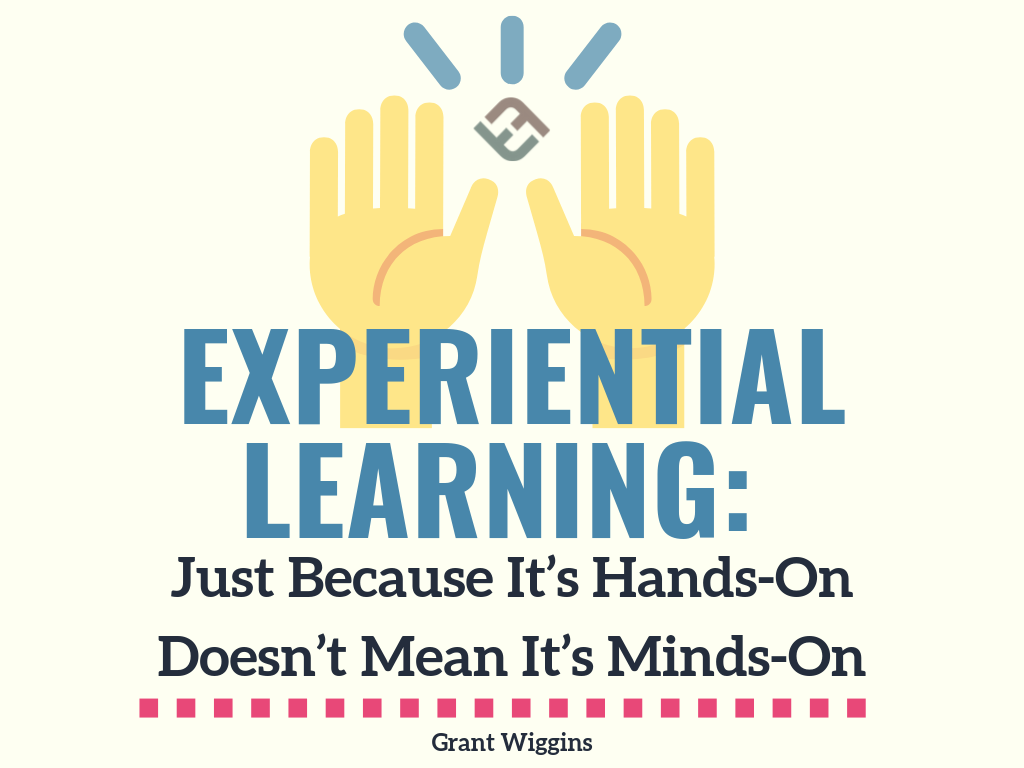
Experiential Learning: Just Because It’s Hands-On Doesn’t Mean It’s Minds-On
Ed note: On May 26, 2015, Grant Wiggins passed away. Grant was tremendously influential on TeachThought’s approach to education, and we were lucky enough for him to contribute his content to our site. Occasionally, we are going to go back and re-share his most memorable posts. This is one of those posts. Thankfully his company, Authentic Education, is carrying on and extending the work that Grant developed.
by Grant Wiggins, Authentic Education
I recently visited Thetford Academy in Vermont (one of the few and interesting public-private academies in New England) where they have a formal and explicit commitment to “experiential learning.” So, the leaders of the school asked me to visit classes that were doing experiential learning and to talk with staff at day’s end about it.
I saw some great examples of such instruction. I visited the design tech course (see photos) and the class on the Connecticut River where students were learning about soil types prior to a wetlands field trip.


I also spent the previous day at the Riverdale School where all 9th graders were learning the skills and habits of innovation and entrepreneurship as part of a cool new project headed by John Kao, former Harvard Business School innovation guru. (I am a consultant to the Edgemakers project).
Below are some pictures from the “Design a better backpack exercise” that started the work of the day.


Just because it’s hands-on doesn’t mean it’s minds-on. But the gist of my remarks at Thetford was to propose caution. Just because work is hands-on does not mean it is minds-on. Many projects, problems, situations, and field trips do not yield lasting and transferable learning because too little attention is given to the meta-cognitive and idea-building work that turns a single experience into insight and later application.
Years ago when I worked as a consultant at School Without Walls in Rochester NY (one of the first really interesting alternative High Schools to emerge from the 60s and a member of the Coalition of Essential Schools), they put it very succinctly in their caution about all the independent projects students routinely did. If you were going to learn carpentry to build a chair, then “The learning is not the chair; it is the learning about learning about chairs, chair-making and oneself.”
I have also often used the following soccer example because it makes the same point beautifully and practically. Merely playing the game over and over need not cause understanding and transfer. It takes a deliberate processing of the game experience, as summarized in the powerful approach used by my daughter’s high school coach a few years back. Instead of talking on and on at players at half-time, Griff asked 4 key questions of players:
-
- What’s working for us?
- What’s not working for us?
- What’s working for the other team?
- So, what do we have to do in the 2nd half?
My daughter (now a starter at Stony Brook University) has often remarked that Griff was really the only coach through HS that taught her to ‘think soccer’ and it paid off in her growth and the team’s success.
As a coach of soccer, baseball, and Socratic Seminar, I learned this lesson the hard way many times myself. I often over-estimated student understanding as to the purpose of activities and assignments, and the important learnings from the experiences. My teaching became far more focused and effective when I forced kids to be metacognitive and reflective about what had been achieved against goals. So, for example, 30 years ago I used a variant of Griff’s questions towards the end of each Socratic Seminar:
-
- What have been the highlights?
- What have been the rough spots?
- What do we now understand?
- What do we still not understand?
- Whose voices didn’t we hear? Why?
With the Thetford staff I prompted a focused discussion in a 2-part exercise: What is the difference between effective and ineffective experiential learning? What are the key indicators to look for in judging whether your attempt at experiential learning is working? (Hint: mere engagement is NOT sufficient.) You might try this exercise locally.
The answers are not surprising but worth committing to. One of the most frequent answers is a clear and specific sense of purpose, linking the activity to the WHY? question – We’re doing this because… We’re learning this because… etc. The other common answer is that the activity needs to be processed in terms of what was and wasn’t learned. (It is key that students explain this independently. Many teachers think that just because they may have said something about purpose at the start that therefore students can answer these questions later on. It is often not the case.)
A third optional part of the exercise is to share examples of the most powerful experiential learning in one’s own experience as a learner to provide a check and to go beyond the earlier answers.
I always ask all kids when I visit class the three questions at the heart of this caution:
- What are you doing?
- Why are you doing it?
- What does this help you do that’s important?
Alas, many kids do not provide adequate answers. And that’s why we need to worry about merely hands-on learning – even as hands-on learning is vital for making abstractions come to life.
This article was excerpted from a post that first appeared on Grant’s personal blog; Experiential Learning: Just Because It’s Hands-On Doesn’t Mean It’s Minds-On; image attribution flickr user nasagoddardacademy